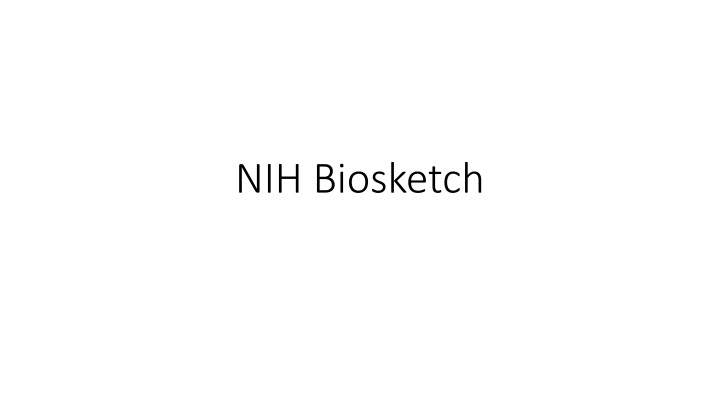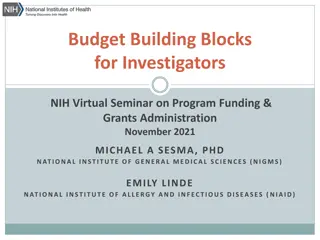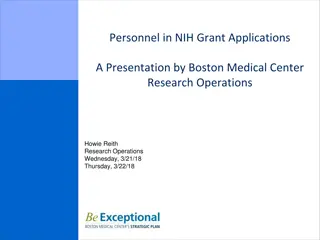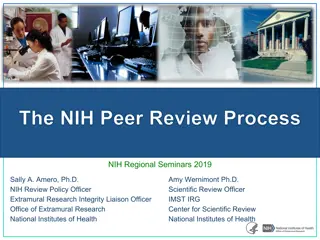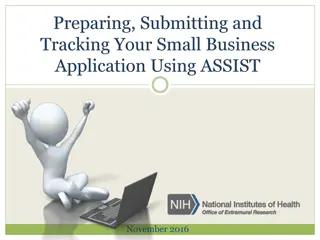NIH Biosketch
This content provides guidance on creating a detailed NIH Biosketch highlighting a researcher's qualifications, achievements, and contributions in a concise format. It includes sections for personal information, educational background, research experience, and publications to showcase the researcher's expertise to potential collaborators and reviewers.
Download Presentation

Please find below an Image/Link to download the presentation.
The content on the website is provided AS IS for your information and personal use only. It may not be sold, licensed, or shared on other websites without obtaining consent from the author.If you encounter any issues during the download, it is possible that the publisher has removed the file from their server.
You are allowed to download the files provided on this website for personal or commercial use, subject to the condition that they are used lawfully. All files are the property of their respective owners.
The content on the website is provided AS IS for your information and personal use only. It may not be sold, licensed, or shared on other websites without obtaining consent from the author.
E N D
Presentation Transcript
Personal Information Name: Fill in your name in the "Name" field of the Biosketch Format Page. eRA Commons User Name: If the individual is registered in the eRA Commons, fill in the eRA Commons User Name in the "eRA Commons User Name" field of the Biosketch Format Page. Position Title: Fill in the position title of the senior/key person or other significant contributor in the "Position Title" field of the Biosketch Format Page.
Personal Information Education/Training Complete the education block. Begin with the baccalaureate or other initial professional education, such as nursing. Include postdoctoral, residency, and clinical fellowship training, as applicable, listing each separately. For each entry provide: the name and location of the institution the degree received (if applicable) the month and year of end date (or expected end date). For fellowship applicants only, also include the month and year of start date. the field of study (for residency entries, the field of study should reflect the area of residency training)
A. Personal Statement A. Personal Statement Briefly describe why you are well-suited for your role(s) in this project. Relevant factors may include: aspects of your training; your previous experimental work on this specific topic or related topics; your technical expertise; your collaborators or scientific environment; and/or your past performance in this or related fields. You may cite up to four publications or research products that highlight your experience and qualifications for this project. Research products can include, but are not limited to, audio or video products; conference proceedings such as meeting abstracts, posters, or other presentations; patents; data and research materials; databases; educational aids or curricula; instruments or equipment; models; protocols; and software or netware.
The Ws of the personal statement Who I am, including rationale or hook (general, present) What I have done to prepare, including When, Where (specific, past) Why I am uniquely qualified, including accomplishments (specific, past and present) What next, including potential: (general, present and future https://www.uab.edu/postdocs/images/PersonalStatementMakeoverforNIH.pdf
Personal statement thoughts Best statements were concise, 300 words, but covered all relevant bases. Thin or bloated statements undermined our confidence in the researcher. Best statements adjusted for audience and sounded engaged in science. Statements that used jargon from the start, or throughout the entire piece, lost us. So did statements that seemed perfunctory or hastily composed. Best statements told a story of the person (not the project). o We want to know more than what you did; we wanted to know WHY why you do what you do, why you should be funded what makes you stand out Most of the text we analyzed were from faculty We need to get more samples from postdoctoral fellows and graduate students and analyze those for effectiveness and tips. https://www.uab.edu/postdocs/images/PersonalStatementMakeoverforNIH.pdf
B. Positions and Honors B. Positions and Honors List in chronological order the positions you've held that are relevant to this application, concluding with your present position. List any relevant academic and professional achievements and honors. In particular: Students, postdoctorates, and junior faculty should include scholarships, traineeships, fellowships, and development awards, as applicable. Clinicians should include information on any clinical licensures and specialty board certifications that they have achieved.
C. Contributions to Science C. Contributions to Science Format: Briefly describe up to five of your most significant contributions to science. The description of each contribution should be no longer than one half page, including citations. While all applicants may describe up to five contributions, graduate students and postdoctorates may wish to consider highlighting two or three they consider most significant.
C. Contributions to Science C. Contributions to Science Content: For each contribution, indicate the following: the historical background that frames the scientific problem; the central finding(s); the influence of the finding(s) on the progress of science or the application of those finding(s) to health or technology; and your specific role in the described work.
C. Contributions to Science C. Contributions to Science Content: For each contribution, you may cite up to four publications or research products that are relevant to the contribution. If you are not the author of the product, indicate what your role or contribution was. Note that while you may mention manuscripts that have not yet been accepted for publication as part of your contribution, you may cite only published papers to support each contribution. Research products can include audio or video products (see the NIH Grants Policy Statement, Section 2.3.7.7: Post-Submission Grant Application Materials); conference proceedings such as meeting abstracts, posters, or other presentations; patents; data and research materials; databases; educational aids or curricula; instruments or equipment; models; protocols; and software or netware. You are allowed to cite interim research products. Note: interim research products have specific citation requirements. See related Frequently Asked Questions for more information.
C. Contributions to Science C. Contributions to Science Content: You may provide a URL to a full list of your published work. This URL must be to a Federal Government website (a .gov suffix). NIH recommends using My Bibliography. Providing a URL to a list of published work is not required. Descriptions of contributions may include a mention of research products under development, such as manuscripts that have not yet been accepted for publication. These contributions do not have to be related to the project proposed in this application.
D. Additional Information: Research Support D. Additional Information: Research Support and/or Scholastic Performance and/or Scholastic Performance Research Support As part of the Biosketch section of the application, "Research Support" highlights your accomplishments, and those of your colleagues, as scientists. This information will be used by the reviewers in the assessment of each your qualifications for a specific role in the proposed project, as well as to evaluate the overall qualifications of the research team. List ongoing and completed research projects from the past three years that you want to draw attention to. Briefly indicate the overall goals of the projects and your responsibilities. Do not include the number of person months or direct costs.
